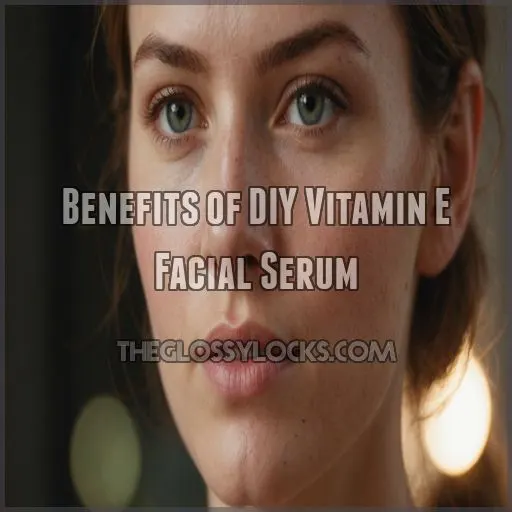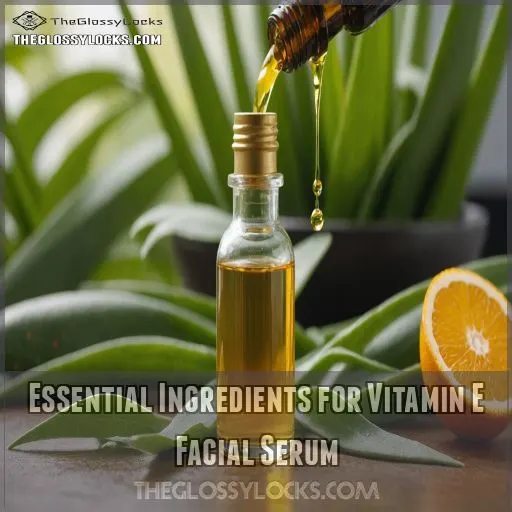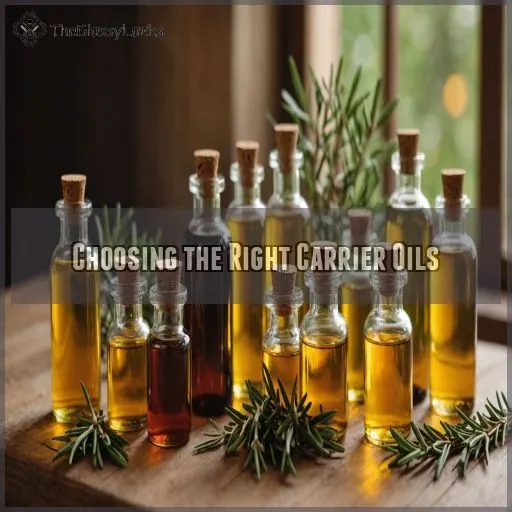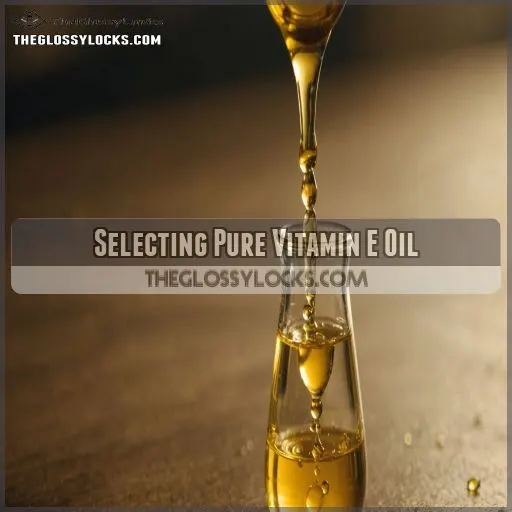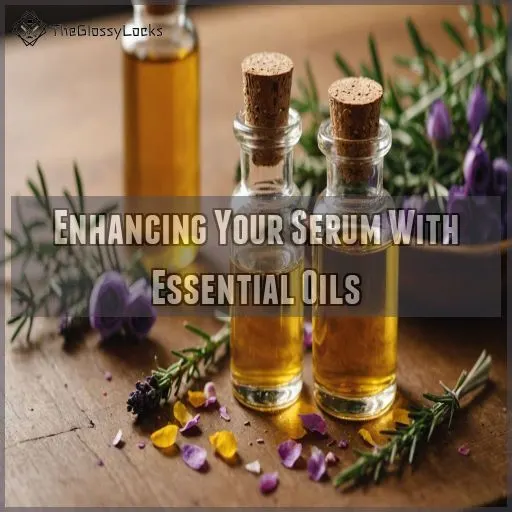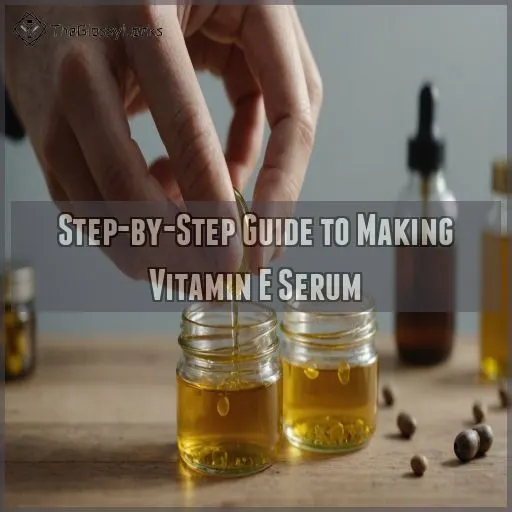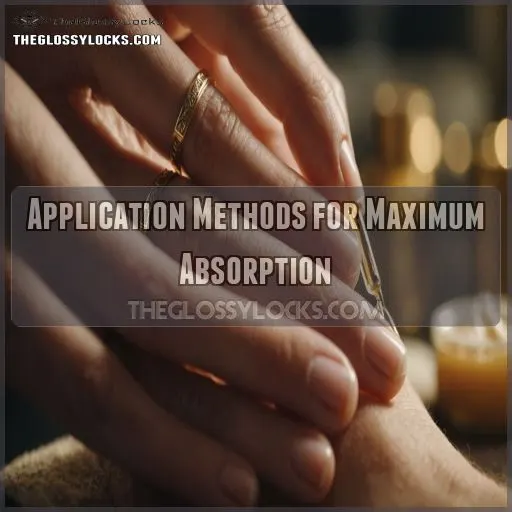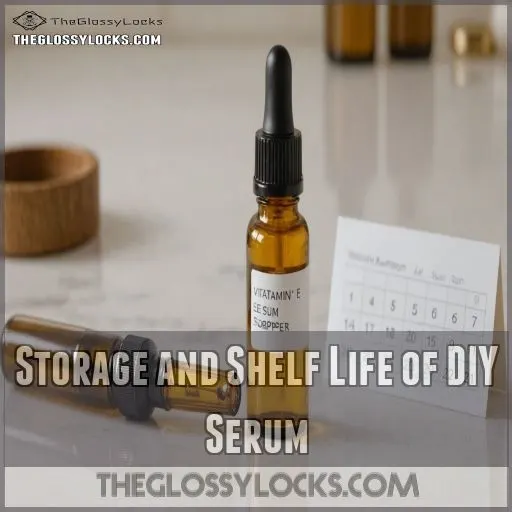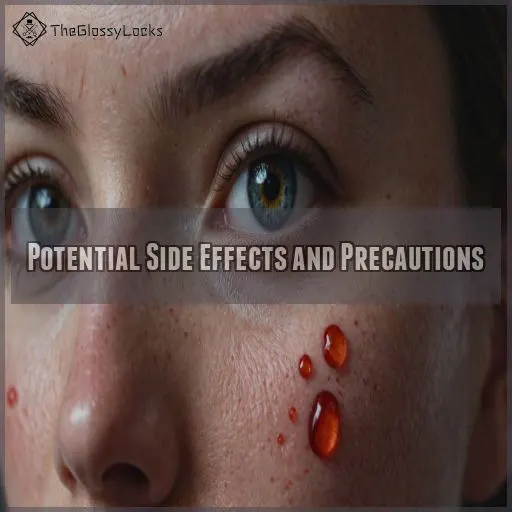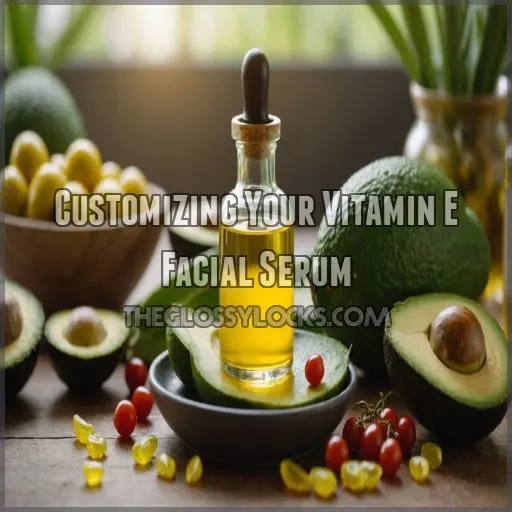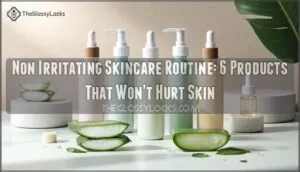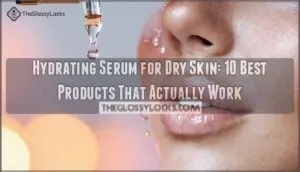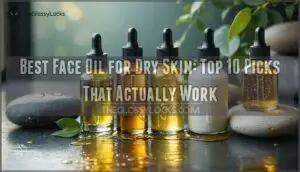This site is supported by our readers. We may earn a commission, at no cost to you, if you purchase through links.
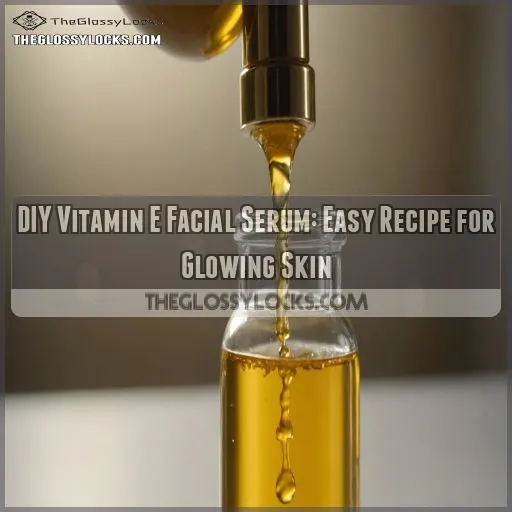 Creating your own DIY vitamin E facial serum is a bit like being a skincare alchemist; you’re mixing ingredients to create magic for your skin.
Creating your own DIY vitamin E facial serum is a bit like being a skincare alchemist; you’re mixing ingredients to create magic for your skin.
Start by gently opening 3-4 vitamin E capsules, squeezing the contents into a clean glass bottle.
Add a tablespoon each of jojoba, rosehip, and argan oils—these are like superfoods for your skin!
Feel free to throw in a drop of lavender oil for a spa-like touch.
Your skin will thank you with a radiant glow.
Curious about how to apply this little potion for maximum benefit or which oils suit your unique skin type best? Read on!
Table Of Contents
- Key Takeaways
- Benefits of DIY Vitamin E Facial Serum
- Essential Ingredients for Vitamin E Facial Serum
- Choosing the Right Carrier Oils
- Selecting Pure Vitamin E Oil
- Enhancing Your Serum With Essential Oils
- Step-by-Step Guide to Making Vitamin E Serum
- Application Methods for Maximum Absorption
- Storage and Shelf Life of DIY Serum
- Potential Side Effects and Precautions
- Customizing Your Vitamin E Facial Serum
- Frequently Asked Questions (FAQs)
- How to make vitamin E serum for face?
- What should I mix with vitamin E for my face?
- Can you use vitamin E as a face serum?
- Can I put 100% vitamin E on my face?
- How often should I use a DIY vitamin E facial serum?
- Can vitamin E serum be used on all skin types?
- How long does a homemade vitamin E serum last?
- Can I mix vitamin E with other skincare products?
- What are the signs that a vitamin E serum is not working?
- Conclusion
Key Takeaways
- Creating your own vitamin E facial serum is like being a skincare wizard; you mix ingredients like jojoba, rosehip, and argan oils to support your skin’s health and glow, while adding some lavender provides a spa-like touch in your routine.
- Think of vitamin E as your skin’s superhero, offering benefits like antioxidant protection, enhanced skin cell regeneration, anti-inflammatory properties, and reducing fine lines while maintaining your skin’s elasticity.
- Choosing the right carrier oils is the secret sauce in your personal potion. Jojoba calms oily skin, rosehip enriches dry skin, almond soothes sensitive skin, and grapeseed keeps acne-prone skin happy without feeling like you’ve slathered your face in pancake batter.
- When applying your serum, remember that quality is more important than quantity; a gentle facial massage after cleansing, paired with storage in a dark, airtight glass bottle, ensures your concoction stays effective. Whether you feel like a scientist or a chef, creativity keeps your serum fresh and your skin radiant.
Benefits of DIY Vitamin E Facial Serum
Creating your own Vitamin E facial serum isn’t just a delightful chemistry experiment, it’s a powerhouse for your skin, offering antioxidant protection, anti-inflammatory properties, and anti-aging benefits in a nourishing, moisturizing elixir.
Think of it as giving your face a superhero cape, helping your skin regenerate and fend off daily aggressors.
Antioxidant Protection
Vitamin E acts as a powerful antioxidant, shielding your skin from free radical damage caused by pollution, UV rays, and other environmental stressors.
This helps prevent premature aging and keep your complexion radiant.
Skin Cell Regeneration
Imagine your skin as a bustling city.
When you apply your Vitamin E facial serum, it’s like giving your skin city a fresh start!
It boosts skin cell turnover, promoting healthy cell growth and skin repair while enhancing collagen production and elasticity.
Anti-inflammatory Properties
Does your skin rebel with redness or flare up like a drama queen plagued by pimples?
You’re in luck! Vitamin E serum, combined with essential oils, can calm acne inflammation, soothe eczema, and bring relief from psoriasis.
Anti-inflammatory properties are the key to its success.
Anti-aging Effects
Wave goodbye to those pesky fine lines, as the efficacious anti-aging effects of vitamin E oil take center stage. It supports:
- Collagen production,
- Skin elasticity,
- Ferulic acid-powered wrinkle reduction,
- Youthful, vibrant skin transformation.
Moisturizing and Nourishing
Beyond antioxidant protection, this vitamin E serum deeply nourishes and moisturizes your skin.
The carrier oils and vitamin E work together to quench dryness and leave your complexion soft, supple, and radiant.
Essential Ingredients for Vitamin E Facial Serum
To whip up your own DIY vitamin E serum, you’ll need superhero skincare ingredients.
Start with pure vitamin E oil for its antioxidant prowess; it’s like a knight in shining armor for your face.
For added benefits, combine essential oil blends that suit your skin’s temperament—think geranium for balance or lavender for calmness.
Make sure the oils are pure by sourcing them from reliable providers.
Crafting this homemade serum with carrier oil benefits lets you master your skincare routine while embracing a natural skincare approach. Learn more about carrier oil benefits.
Choosing the Right Carrier Oils
Choosing the right carrier oil for your DIY Vitamin E Facial Serum can make all the difference in addressing your skin’s specific needs.
Whether your skin is oily, dry, sensitive, or acne-prone, there’s a perfect oil for you to make sure your face feels fabulous and not like a morning pancake.
Jojoba Oil for Oily Skin
Before crafting your serum, knowing your skin type helps.
Ever tried jojoba oil for oily skin? It mimics natural skin oils and helps balance the skin without clogging pores.
- Benefits: Controls oil production
- Acne relief
- Easy absorption
Rosehip Oil for Dry Skin
Rosehip oil is a godsend for dry skin, deeply nourishing and plumping the complexion, just like a good body oil. Its high vitamin C content also helps reduce the appearance of fine lines and wrinkles.
Hemp Seed Oil for Combination Skin
Have combination skin? Hemp seed oil might be your golden ticket—balancing becomes a breeze! Here’s why it shines:
- Lightweight: Doesn’t clog pores.
- Hydrates: Holds moisture.
- Versatile: Complements your homemade face serum perfectly.
Almond Oil for Sensitive Skin
Almond oil is your trusty sidekick when searching for gentle care. With its soothing properties, it’s ideal for sensitive skin care. Use it in your vitamin E serum for nourishing benefits without irritation.
Almond oil is a great choice for your skincare routine because it’s:
Gentle on Skin
Rich in Nutrients
Lightweight Feel
Almond oil is also a great choice for DIY serums because it:
Blends Easily
Hydrates Well
Absorbs Quickly
| Almond Oil Benefits | DIY Serum Tips |
|---|---|
| Gentle on Skin | Blends Easily |
| Rich in Nutrients | Hydrates Well |
| Lightweight Feel | Absorbs Quickly |
Grapeseed Oil for Acne-Prone Skin
For acne-prone skin, grapeseed oil is your go-to magic potion.
Its light texture won’t clog pores, making it perfect for oil cleansing.
Packed with antioxidants, it supports your DIY vitamin E serum, enhancing natural beauty and skin health and protecting cells from free radical damage.
Selecting Pure Vitamin E Oil
When crafting your DIY vitamin E facial serum, selecting a high-quality, pure vitamin E oil is really important.
Look for reputable brands that offer third-party testing results to make sure the oil’s purity and potency,
as this will maximize the serum’s skin-nourishing benefits.
Choosing Quality Vitamin E
Once you’ve nailed your carrier oil choice, it’s time to zero in on quality Vitamin E oil. Don’t settle for less.
Look for:
- Cold-pressed oil for max potency.
- Organic certification to guarantee pureness.
- Therapeutic grade labeling for guaranteed skin hydration.
Trust these tips, and your serum will have you glowing like the sun!
Evaluating Oil Purity Levels
Evaluating oil purity levels for your vitamin E serum might seem like searching for a needle in a haystack, but once you know what to sniff out, it’s a walk in the park!
Look for certifications that guarantee quality.
Assess the oil’s color and viscosity.
Trust your nose and touch. Good oils, like argan or sunflower, shouldn’t smell funny or feel greasy.
Identifying Trusted Oil Sources
Picking trusted sources for vitamin E oil makes sure your serum’s quality doesn’t hit the skids.
Look for cold-pressed, organic options with third-party certification.
Small-batch producers often prioritize ethical sourcing over mass-produced brands.
Think of it as choosing between a homemade pie and a store-bought one – for the sake of your skin, choose wisely and enjoy gleaming, healthy skin!
Enhancing Your Serum With Essential Oils
Elevate your DIY vitamin E serum by incorporating the power of essential oils like those found in Dr. Denese’s Essential Lipid Anti-Aging Power Infusion.
From balancing geranium to soothing chamomile, these aromatic additions can enhance your skin’s radiance and target specific concerns.
Geranium for Balancing
Geranium oil packs a punch in your vitamin E serum, balancing hormones and soothing oily or sensitive skin.
It’s like the peacekeeper in a skincare routine, blending well in DIY recipe variations.
Ready for glowing skin? Massage gently!
Frankincense for Anti-Aging
Onward from geranium, you’ve got Frankincense, a true ancient beauty secret. Its anti-aging benefits stand toe-to-toe with retinol, aiding your skin’s aging process.
Incorporate it for:
- Firmer skin
- Reduced wrinkles
- Even tone
- Improved elasticity
- Calmer complexion
Chamomile for Soothing
Chamomile’s wonders can make your Vitamin E serum a superstar!
It’s like a gentle hug for your skin—calming irritation and reducing inflammation.
This DIY blend is perfect for sensitive skin, offering soothing relief in your beauty routine.
Lavender for Calming
Lavender’s calming aroma can soothe stressed skin.
Lavender’s anti-inflammatory properties reduce redness and irritation.
Add a few drops of lavender oil to your vitamin E serum for a relaxing, tension-releasing facial massage with a gua sha stone.
Tea Tree for Acne-Fighting
Tea tree oil is a trusty sidekick when combating acne.
It is known for its effectiveness comparable to benzoyl peroxide.
Dilute it for safe use in your vitamin E serum.
Ideal for sensitive and oily skin, tea tree tackles cystic acne.
Step-by-Step Guide to Making Vitamin E Serum
Creating your own vitamin E facial serum is a simple and rewarding process that lets you take charge of your skincare routine.
With just a few ingredients and some mixing, you’ll be on your way to smoother, glowing skin.
You can achieve this without breaking the bank or turning your bathroom into a science lab.
Measuring and Mixing Ingredients
You’ve explored essential oils, now it’s time to measure and mix your vitamin E serum.
Grab your measuring tools and get the ratios right for your skin type—be it oily, dry, or sensitive.
Use sturdy storage containers for a serum that fights melanin formation and lasts.
Proper Blending Techniques
Once you’ve measured your carrier and vitamin E oils, it’s time to blend them together.
Start by adding the vitamin E oil first, then slowly incorporate the carrier oil, stirring gently to create a smooth, even consistency.
Be mindful of temperature – avoid overheating the mixture.
- Blend in a circular motion
- Adjust oil ratios for your skin type
- Check for a silky, uniform texture
Adding Essential Oils
You’ve mastered blending your carrier and vitamin E oils, so now it’s time to spice it up with essential oils.
Add a few drops of your favorite like lavender or tea tree.
Remember, a little goes a long way!
It’s like adding sprinkles to your skincare cupcake.
Transferring to Storage Container
Storing your vitamin E serum properly is essential to ensure its effectiveness.
Choose a glass, amber bottle to protect your serum from light.
Make sure the bottle is airtight to prevent oxidation and maintain freshness.
Whether you’re treating acne or dry skin, proper storage allows your serum to work its magic!
Application Methods for Maximum Absorption
Mastering how to apply your DIY vitamin E facial serum can enhance its effectiveness and make sure your skin reaps maximum benefits.
Boosting absorption and making your skincare routine feel more like a luxurious spa experience can be achieved by incorporating techniques like facial massage and using tools such as a Gua Sha stone.
Facial Massage Techniques
Gently massage the serum into your skin using circular motions and light pressure.
This helps boost lymphatic drainage, release facial muscle tension, and improve product absorption for maximum benefits.
Focus on pressure points around the eyes, cheeks, and jawline to stimulate circulation and give your complexion a healthy glow.
Using Gua Sha Stone
Elevate your skincare game with the magic of Gua Sha! This ancient tool boosts skin circulation and absorption, transforming your DIY Vitamin E Serum experience into a spa-like ritual.
- Relaxing ritual: Create a serene moment.
- Facial benefits: Target dark spots with precision.
- Aloe vera refresh: Pair with calming rose water.
- How to antidote: Like a banana honey face mask, it’s pure bliss.
Incorporating Into Skincare Routine
Brighten your morning routine by applying the serum post-cleansing; it’s like giving your skin a morning coffee!
Start with just a few drops, adjusting for skin type variations.
In your evening routine, indulge in a gentle massage for deeper absorption.
DIY frequency? Keep it reasonable—nightly works wonders.
Storage and Shelf Life of DIY Serum
To keep your DIY vitamin E facial serum fresh and effective, choosing the right container and storage conditions is essential.
Don’t blink an eye at spoilage—watch out for changes in smell, color, or texture, which could mean it’s time to toss it.
Choosing the Right Container
For storing your homemade vitamin E serum, choose a glass container over plastic.
Glass bottles protect the delicate oils from light exposure and create an airtight seal to preserve freshness.
Choose a size that fits your usage needs, and don’t forget to label the bottle with the date you made it.
Proper Storage Conditions
You’ve got that perfect container, now keep your serum in tiptop shape!
Store it away from light exposure—nobody likes a sunburned serum.
Aim for cool temperatures; think cozy—not frostbite!
Use airtight containers to protect that precious blend from contamination risks.
Give your serum a long shelf life by keeping it snug and secure, ensuring every drop stays fab!
Signs of Spoilage
Store your serum smartly, but know when it’s gone rogue!
Keep an eye out for color changes or an odd smell—like your grandma’s old perfume.
Is the texture changing or oil separating?
Major red flags!
And if you spot mold growth, it’s time for a breakup.
These signs whisper, "Time to whip up a fresh batch!
Potential Side Effects and Precautions
While DIY Vitamin E serums can do wonders for your skin, you should take precautions to avoid unexpected reactions.
Test for allergies first, as your face is sensitive.
Skip daytime citrus oils to avoid irritation.
Stop using the serum if irritation occurs.
Patch Testing for Allergies
Before applying your homemade vitamin E serum, be sure to patch test it first.
This helps you suss out any potential skin sensitivities or allergic reactions.
Simply dab a small amount on your inner arm or behind your ear, and keep an eye out for:
- Redness
- Itching
- Swelling
- Rash
- Burning sensation
Give it 24-48 hours to see how your skin reacts before proceeding with full-face application.
Avoiding Sun Exposure With Citrus Oils
Avoiding citrus oils in your daytime serum can prevent sun sensitivity. These oils can cause phototoxicity, leading to skin irritation. Before you know it, you’ll be thinking sunscreen is your best friend.
Here’s a quick guide:
| Citrus Oils | Sun Sensitivity | Safe Application Tip |
|---|---|---|
| Lemon | High | Use at night |
| Lime | Moderate | Dilute well |
| Grapefruit | High | Always use SPF |
| Orange | Moderate | Avoid direct sun |
| Bergamot | Very High | Use sparingly |
Discontinuing Use if Irritation Occurs
Even superheroes have kryptonite, and your Vitamin E serum might be your skin’s! If irritation occurs, it’s time to stop using.
Trust your skin’s signals:
- Skin Sensitivity: Watch for redness or itchiness.
- Patch Testing: Always test new products.
- Allergic Reactions: Discontinue immediately if severe.
- Ingredient Swap: Consider alternative oils.
- Stop Use: Listen to your skin!
Your face knows best!
Customizing Your Vitamin E Facial Serum
Crafting your perfect Vitamin E facial serum is like preparing a smoothie – you can adjust ingredients to match your taste and needs.
Mix different oil ratios, toss in complementary ingredients, and watch your serum evolve with the seasons for skin that’s always in style!
Adjusting Oil Ratios for Skin Type
Adjusting the oil ratios in your DIY vitamin E serum is key to targeting your specific skin type.
For oily skin, use more lightweight oils like grapeseed or jojoba.
Dry complexions do well with richer oils like rosehip or almond.
Combination skin types can balance with a blend of oils.
Tweak the formula until it feels just right for your complexion.
Adding Complementary Ingredients
Spicing up your DIY serum ideas can give your skin that extra oomph.
Consider adding complementary ingredients like plant extracts or hyaluronic acid for a boost.
Here’s a quick list to let those creative juices flow:
- Aloe Vera: Soothes and hydrates.
- Green Tea Extract: Antioxidant booster.
- Rose Water: Natural alternative for calming redness.
Don’t hold back—your skin deserves it!
Seasonal Variations in Formula
Seasonal changes can make your skin feel like it’s on a rollercoaster.
To balance it out, tweak your Vitamin E serum for the seasons.
Check out this guide:
| Season | Oil Blend | Benefit |
|---|---|---|
| Summer | Grapeseed | Lightweight |
| Fall | Almond | Nourishing |
| Winter | Rosehip | Hydrating |
Customize for control, so you glow year-round!
Frequently Asked Questions (FAQs)
How to make vitamin E serum for face?
Make your own vitamin E serum by combining essential oils, like frankincense, with pure vitamin E and carrier oils such as jojoba.
Apply a few drops before bedtime, ensuring you store it in a tinted glass bottle.
What should I mix with vitamin E for my face?
Combine vitamin E with carrier oils suited to your skin type, like jojoba for oily skin or almond for dry skin.
Add a touch of essential oils like rose or frankincense for anti-aging perks.
Can you use vitamin E as a face serum?
Get the ball rolling with vitamin E for your face; it’s like a protective net for your skin.
Use it as a serum to combat free radicals, enhance hydration, and smooth wrinkles.
But watch for sensitivities!
Can I put 100% vitamin E on my face?
You can use 100% pure vitamin E oil on your face, but it’s best to dilute it with a carrier oil first.
This helps prevent potential irritation or clogged pores.
Start with just a few drops mixed into your favorite moisturizer.
How often should I use a DIY vitamin E facial serum?
Imagine painting your skin with a shield of sunlight—use your DIY vitamin E facial serum sparingly, about 2-3 times a week.
Too much can clog pores, so let your skin breathe and sparkle wisely!
Can vitamin E serum be used on all skin types?
Vitamin E serum suits most skin types, acting as a moisturizer and protector against environmental damage.
Oily or acne-prone skin should be tested cautiously, as its richness might sometimes lead to clogged pores or breakouts.
How long does a homemade vitamin E serum last?
Homemade vitamin E serum, when stored wisely—think amber glass bottles tucked away from light and heat—can last about 6 to 12 months.
Proper storage is key for maximizing shelf life.
Always check for any funky smells or changes in texture.
Can I mix vitamin E with other skincare products?
Mixing vitamin E with other skincare products can be like a symphony of nourishment for your skin – just be sure to do a patch test first to make sure it’s compatible with products like the Power Repair Hydrating Cleanser.
With the right combinations, you’ll be glowing in no time!
What are the signs that a vitamin E serum is not working?
If your skin’s not getting smoother, fine lines are sticking around like unwanted guests, or irritation shows up to the party, your serum might not be pulling its weight.
Give it time, but trust your skin’s signals.
Conclusion
By now, you’ve made your own Vitamin E facial serum! It’s like bottled sunshine for your face, providing antioxidant protection and hydration in every drop.
Get started making your own, knowing you’ve chosen the right oils and essential ingredients.
Don’t neglect the application tips and storage advice—these tiny details make a big difference.

